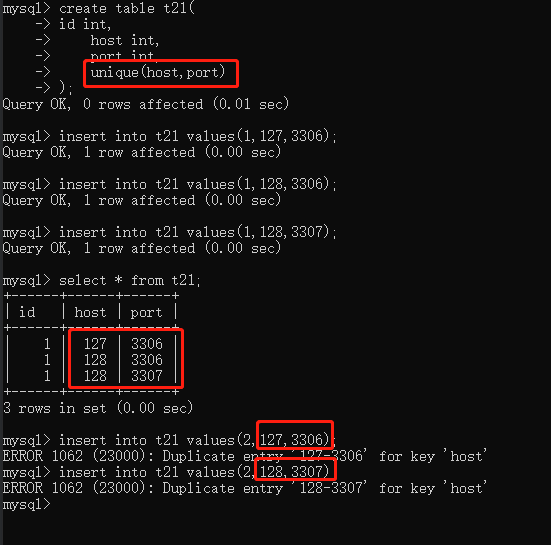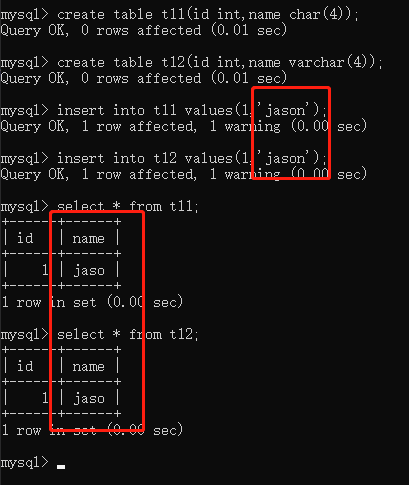数据库入门3
存储引擎
概念
MySQL内部针对数据的存储有很多不同的方式,我们可以简单地把这些存储方式理解为存储引擎。
查看方法
输入:show engines;
主要的存储引擎
InnoDB
MySQL5.5之后的版本默认的存储引擎。
支持事务、行锁、外键,这样会让数据更安全。
事务:保证多个数据的操作要么全部完成要么全部失败
行锁:多一行行数据加锁 同一时间只能有一个人操作
外键:建立表关系(后面详细的讲)
MyISAM
MySQL5.5之前的版本默认的存储引擎
由于不支持事务、外键等功能,所以安全性和InnoDB相比较低,但是存取数据的速度比InnoDB更快。
memory
数据直接存在内存,速度快但是断电立刻丢失。
blackhole
写入其中的数据都会丢失。
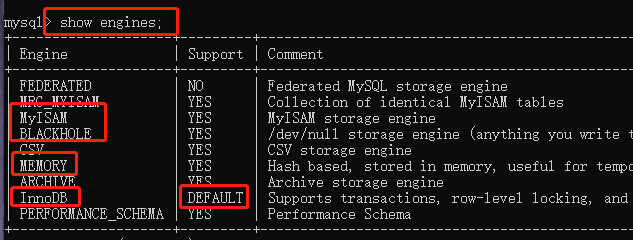
存储引擎表文件
create table t1(id int)engine=InnoDB; create table t2(id int)engine=MyISAM; create table t3(id int)engine=memory; create table t4(id int)engine=blackhole;
不同的存储引擎生成的文件数量不同
InnoDB有两个文件
.frm 表结构
.ibd 表数据、索引(相当于书的目录)
MyISAM有三个文件
.frm 表结构
.MYD 表数据
.MYI 表索引
memory有一个文件
.frm 表结构
blackhole有一个文件
.frm 表结构

存储数据特性
insert into t1 values(1); insert into t2 values(1); insert into t3 values(1); insert into t4 values(1);
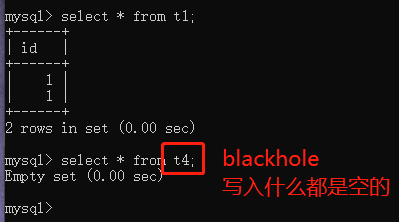
创建表的完整语法
create table 表名( 字段名 字段类型(宽度) 约束条件, 字段名 字段类型(宽度) 约束条件, 字段名 字段类型(宽度) 约束条件 );
注意:
1.字段名和字段类型是必须的,宽度和约束条件是可选的。
2.约束条件可选,并且一个字段可支持多个约束条件。
3.最后结尾的字段语句不能有逗号。
字段类型
整型
整型的分类有:tinyint,smallint,int,bigint,不同的整型类型能存储的数字范围是不同的。
默认的整型都是带正负号的。
消除符号的方法--unsigned
create table t7(id tinyint unsigned); # unsigned约束条件 无符号 insert into t7 values(-129),(256); # 0 255
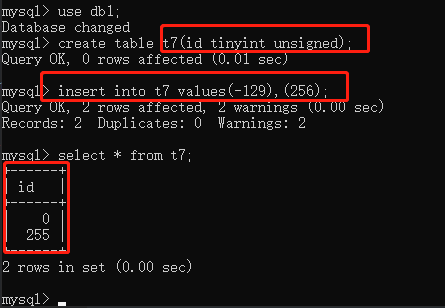
浮点型
浮点型的分类有:float,double,decimal,不同的浮点型存储小数的范围和精度不一样。
float(255,30) # 总共255位小数位占30位 double(255,30) # 总共255位小数位占30位 decimal(65,30) # 总共65位小数位占30位 create table t8(id float(255,30)); create table t9(id double(255,30)); create table t10(id decimal(65,30)); insert into t8 values(1.111111111111111111111111111111); insert into t9 values(1.111111111111111111111111111111); insert into t10 values(1.111111111111111111111111111111); # 精确度:float < double < decimal
精确度问题在很多场景下都会发生 有时候我们会采取不同的类型来存储,比如手机号全部是数字存储的时候应该使用整型 但是有时候我们使用字符类型。
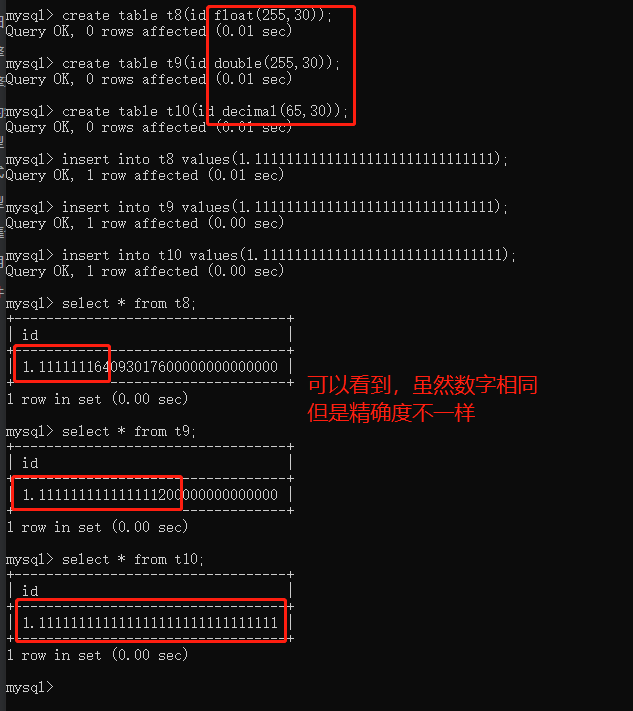
字符类型
字符类型分为:char和varchar,这两个数据类型在存储数据上有本质的区别
char(4)
最多可以存储4个字符,超过了报错,没有超过也按照四个字符存储,默认空格填充。
varchar(4)
最多可以存储4个字符,超过了报错,没有超过则按照实际有几个字符存几个。
create table t11(id int,name char(4)); create table t12(id int,name varchar(4)); insert into t11 values(1,'jason'); insert into t12 values(1,'jason');
5.6版本超出了范围没有报错是因为我们没有开启严格模式(5.7及之后版本默认都有)
char_length() 统计数据长度
默认情况下MySQL会自动填充存储并在查询的时候自动去除填充的空格
set global sql_mode="strict_trans_tables,PAD_CHAR_TO_FULL_LENGTH";
严格模式
查看严格模式
show variables like '%mode%';
修改严格模式
set global sql_mode = 'strict_trans_tables';
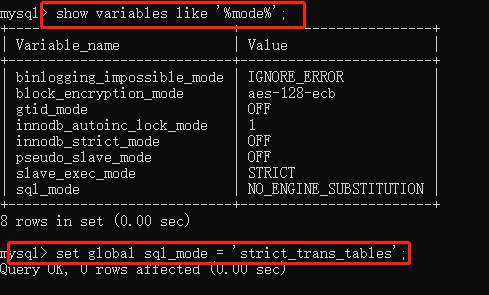
最后需要退出客户端重新进入

时间类型
date 年月日
time 时分秒
Datetime 年月日时分秒
Year 年
create table student(
id int,
name char(16),
born_year year,
birth date,
study_time time,
reg_time datetime
);
时间数据很多时候都是自动获取,这里仅仅是演示一下
insert into student values(1,'jason','2022','2022-05-09','11:11:00','2022-11-11 11:11:11');

枚举与集合类型
enum:多选一
set:多选多,包含多选一
枚举类型
create table t13(
id int,
name varchar(16),
gender enum('male','female','others')
);
'''插入数据的时候只能够插入提前规定好的'''
insert into t13 values(1,'jason','男'); # 报错
insert into t13 values(2,'tony','male');
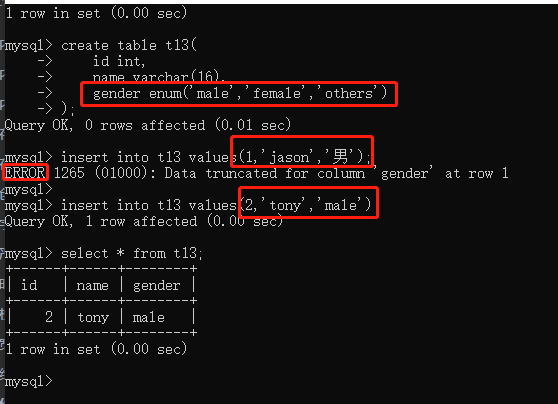
集合类型
create table t14(
id int,
name char(16),
hobby set('basketball','football','doublecolorball')
);
'''插入数据的时候只能够插入提前规定好的'''
insert into t14 values(1,'jason','read'); # 报错
insert into t14 values(2,'kevin','basketball'); # 可选一
insert into t14 values(3,'tony','basketball,football'); # 可选多

宽度说明
针对数字类型,宽度并不是用来限制存储长度而是用来表示展示长度。
但是对数字无效,所以在定义数字的时候不需要手动添加宽度。
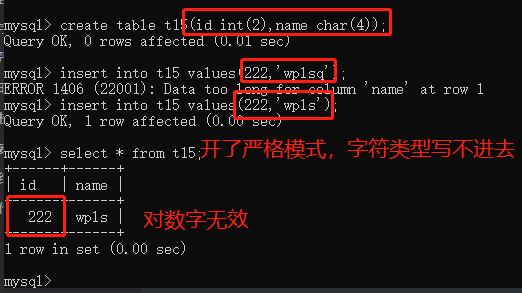
约束条件
插入数据的方式
方式1:insert into t1 values()
这个方式是按照字段顺序依次传入的,一个都不能少。
方式2:insert into t1(id,name) values()
这个方式是按照指定的字段传入,可以少。
unsigned # 无符号 zerofill # 0填充 # unique 唯一 '''单列唯一''' create table t20( id int, name varchar(16) unique ); '''多列唯一''' create table t21( id int, host int, port int, unique(host,port) );
not null 不能为空 使用频率很高
create table t18(
id int,
name varchar(16) not null
);
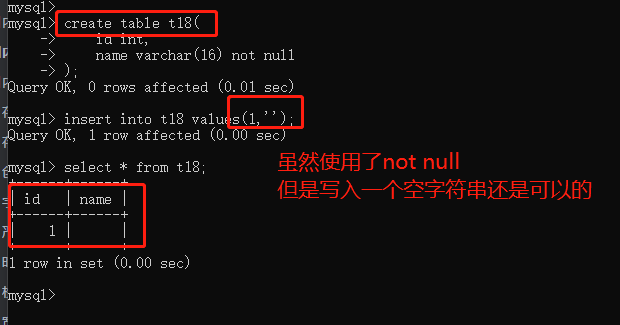
default 默认值
create table t19(
id int,
name varchar(16) default '匿名用户'
);
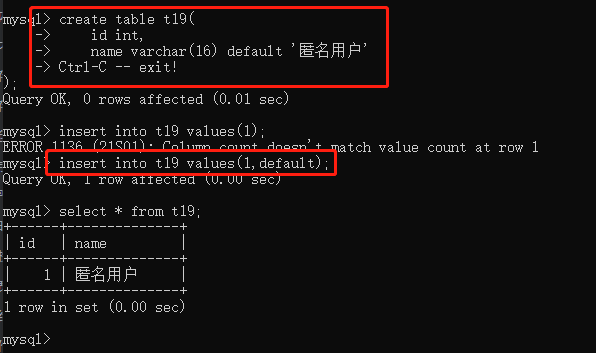
unique 唯一
单列唯一
create table t20(
id int,
name varchar(16) unique
);
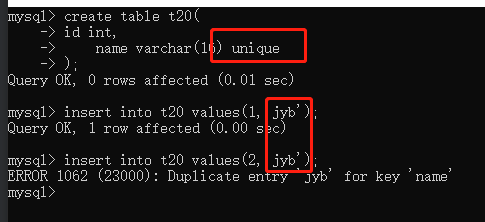
多列唯一
create table t21(
id int,
host int,
port int,
unique(host,port)
);
